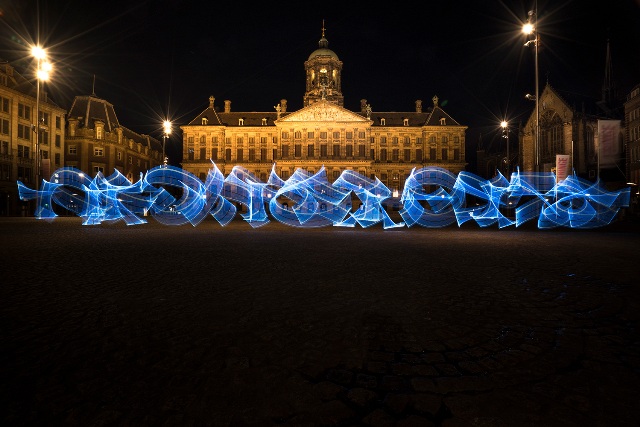
Said Dokins and Leonardo Luna present some amazing works with light calligraphy on their last trip to the Netherlands. Said used the luminic tools he has created to perform a series of calligraphic actions around public spaces, while Leonardo Luna’s lens was capturing them.
At the end, the luminic trace of Said’s actions where revealed through a photographs that reveal the inscriptions Said had traced.
Heliographies of Memory consist in a series of photographs that capture the calligraphic gesture, the very moment where the action of inscription is taking place. But this is not usual calligraphy writing. The texts are written with light, so the words disappear as soon as they were suggested by the moves of the calligrapher, invisible to the simple eye, they just can be captured by a process of long-exposure photography, that reveal what happened, even though no one could see it. Through these ephemeral interventions with light calligraphy, we capture the invisible, acting on air, using as locations iconic places: historic sites, public plazas, monuments, bulwarks, abandoned places become re-signification spaces.
Not long ago we had the chance to visit Netherlands, thanks to the invitation of Amsterdam Urban Art Museum / Street Art Today, Heerlen Murals and Locatie Spatie in Arnhem. Traveling between Amsterdam, Rotterdam, Heerlen and Arnhem we got to know a little part of Netherlands culture and to discover places with a strong historic and symbolic value. The project was titled ‘Inscription and Erasure’ and was focused to obsolescence spaces, where history is rewritten in different levels, sometimes hiding the trace of time, some other times, evoking the old days nostalgia.
One of the most stunning experiences was visiting Radio Kootwijk, a small village with around 120 inhabitants, in Apeldoorn municipality. Intentionally isolated in the middle of the woods of Veluwe region, A Building was constructed in 1917, designed by the architect Julius Maria Luthmann. It had the important role of housing a communicational complex where trans-Atlantic connections were established between the Netherlands and the Dutch East Indies (today Indonesia) during the Second World War.
The obsolescence of Radio Kootwijk was due to the development of new technologies, radio transmissions were changed by satellite communication. Even though the radio transmitters where destroyed, Building A stands as a monument to this history, presenting the reinforced concrete and all the characteristics of Art Decó.
In order to do this piece, we went through many adventures. We parked in a forbidden spot, then we walked 20 minutes on a rocky track, where wild boars where ready to attack us, finally, in the middle of nowhere, there was the tower. It was slightly raining, and while we were shooting, police arrived and kicked us out of the place, we didn’t know it was forbidden to be there at night and take photos. We were able to do just two shots, but it was one of the sessions we enjoyed the most.
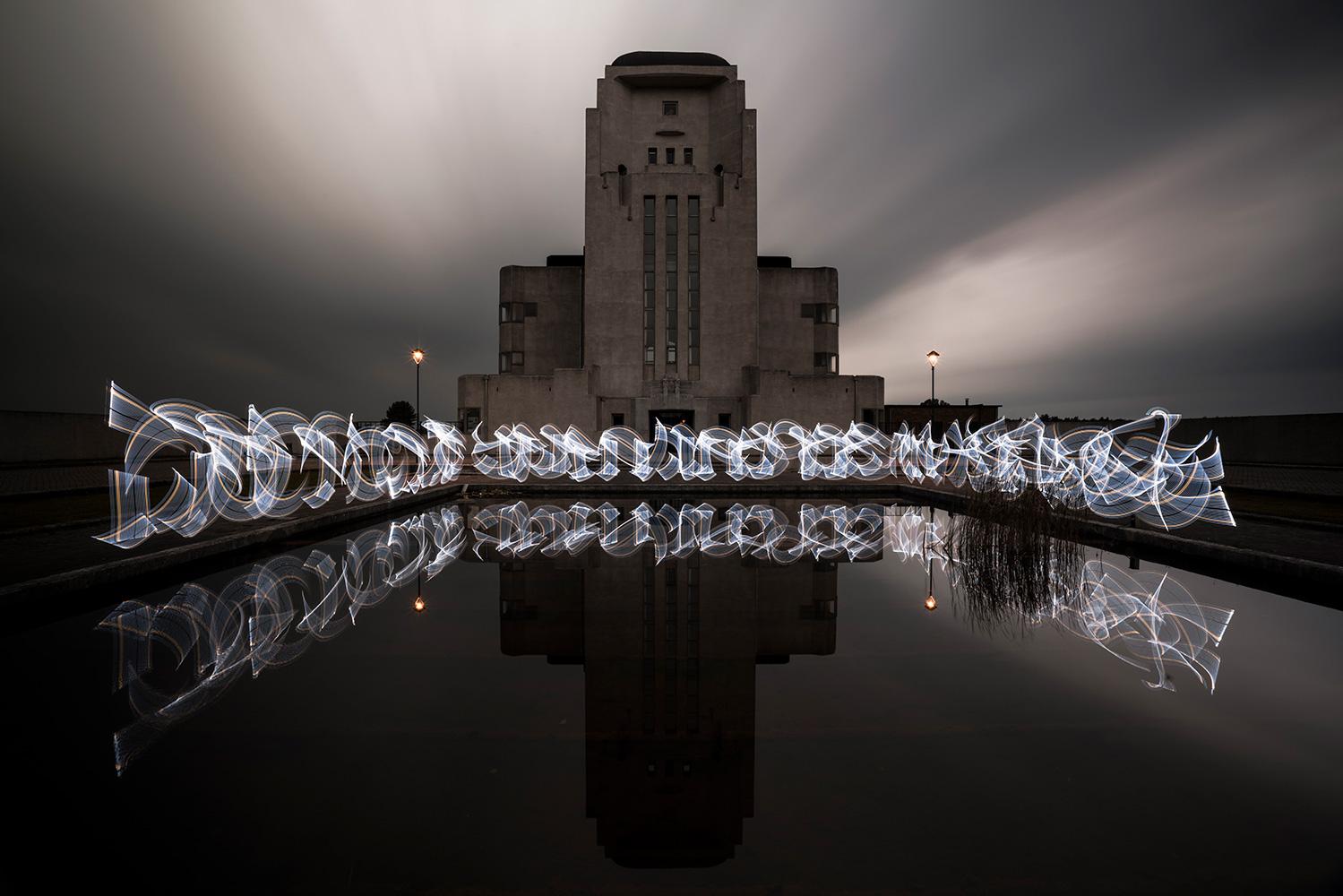
Said Dokins & Leonardo Luna, ‘Desplegar el plan natural en toda su amplitud’ (‘To Deploy the Natural Plan in All its Amplitude’), Heliographies of memory series, 2017. Radio Kootwijk, Netherlands.
Heerlen Murals
Owing to Heerlen Murals invitation, we worked during a week on the production of a new series that will be presented next year, as a big format photograph situated in the center of the city, along with a large-scale mural, following with the tradition Heerlen is well-known for: mural intervention.
One of the things that stand out in Heerlen is the palimpsest that at first sight is possible to observe in its architecture: a city with traces of the Roman occupation and Medieval remnants, in contrast to Modernist and Avant-Garde architecture, all along in the same place. In the city center, we can find the most emblematic building in Heerlen, the Glaspaleis, built in 1935 by Fritz Peutz, a jewel of Netherlands modernism. A few steps away, there it is the Pancatiuskerk, a Romanic style church, erected between 10th and 12th centuries. Next to it, we look at the Grass Palace Music School, constructed in 2003 by Jo Coenen, Wiel Arets Architects, an icon of contemporary architecture.
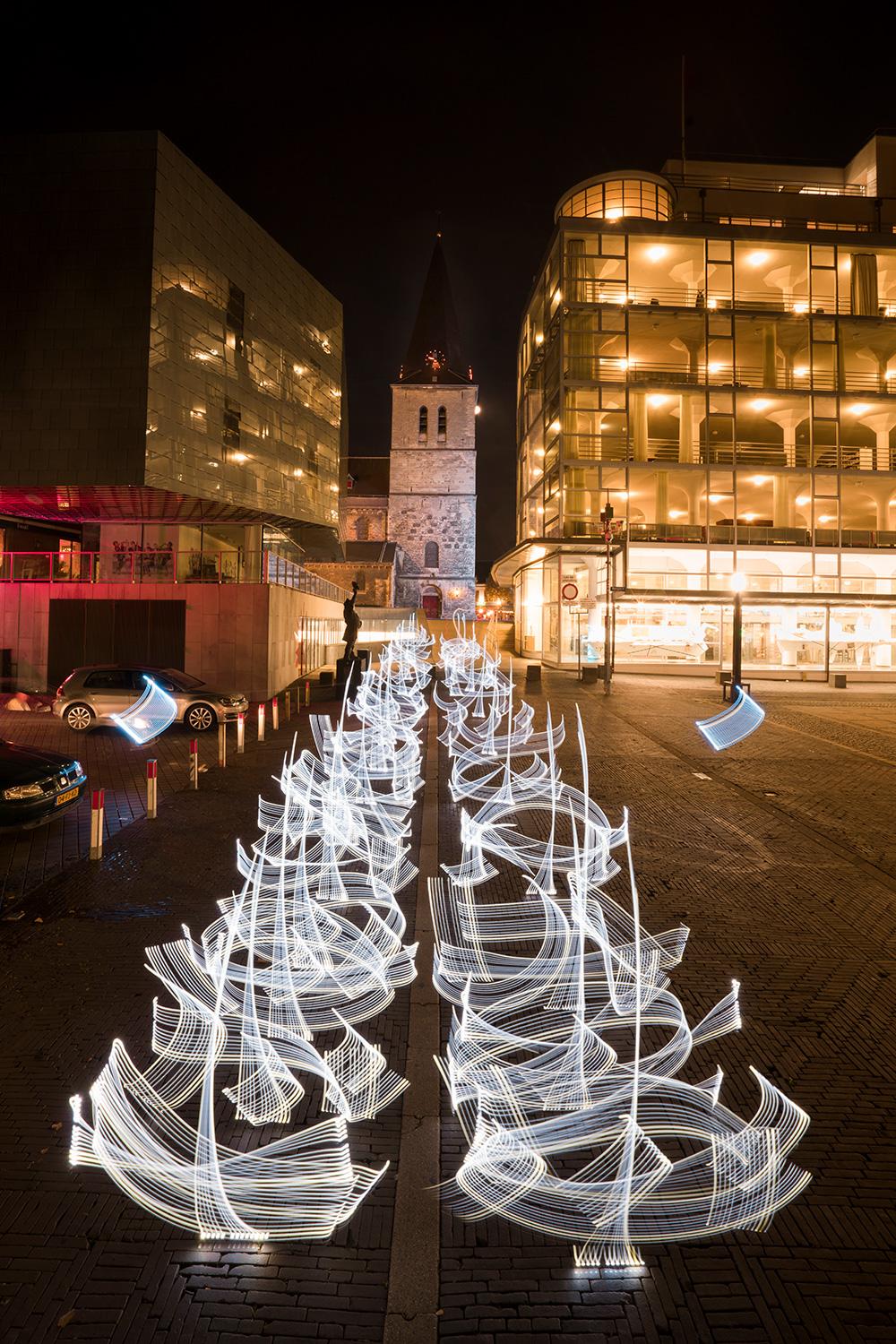
Said Dokins & Leonardo Luna ‘Inscripción y Borradura’ (‘Inscription and Erasure’), Heliographies of Memory series, 2017. Heerlen, Netherlands.
…every erased trace, in consciousness, can leave a trace of its erasure whose symptom (individual, or social, historical, political and so on) will always be capable of ensuring its return.
Jaques Derrida
By the end of the 19th century, Heerlen had become an important industrial center in the Netherlands due to mining. The government ran coal mines as state industries, generating jobs and a population growth without precedents. Coal mining became the basis of the city’s economy. In the early 20th century the industry had a turbulent expansion. During those times, a lot of ancient buildings were destroyed to build new ones, according to the new modern image of Heerlen. However, the glory didn’t last long, by mid-century the coal production stopped being profitable facing the competence of countries like Poland or the United States, as well as the discovery of new energy sources, such as natural gas. Suddenly, Heerlen industry stopped producing, and by the 60’s the coal mines were closed. More than 60000 people lost their jobs. The State relocated some governmental offices (ABP, CBS) to create jobs and ease the crisis, but it didn’t work out entirely. Today they’re still working hard against unemployment and to improve local economy.
Nowadays it’s hard to find traces of the mining industry. Almost every coal mine has been transformed in green hills, through an erasure operation known as ‘Van zwart naar groen’ (from black to green). The old mining area is now called Parkstad Limburg. Material testimonies of the mining past has been rigorously demolished. Just a few monuments still remind us about once dominant industry, perhaps a commercial mall that refers to mining towers shape. It seems that this episode has been deliberately erased, physically and symbolically, despite the great importance it had for local history.
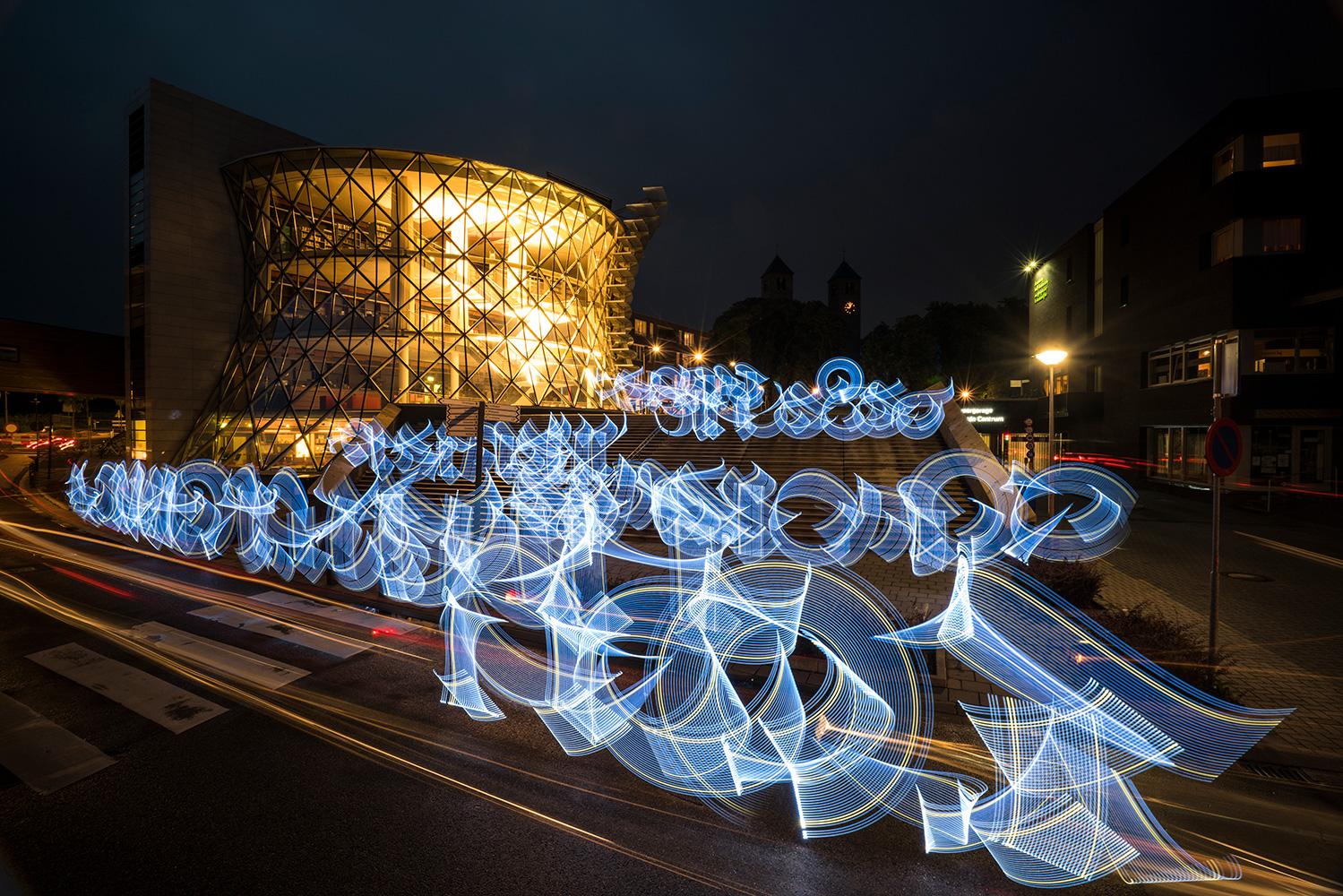
Said Dokins & Leonardo Luna, ‘The return of the ghost’, Heliographies of Memory series, 2017. Heerlen, Netherlands.
Arnhem
We visited Arnhem thanks to the invitation of Locatie Spatie and we decided to work on The Airborne Monument, a monument placed in the center of a memorial situated in front of the John Frost Bridge, dedicated to the fallen soldiers during Market Garden Operation, in the Second World War. The monument is a damaged column that belonged to the Justice Palace, in which appears the inscription: “17 September 1944”, referring to Arnhem Battle. We worked on this piece in the exact day of the Commemoration, and the memorial was full of photographs, flowers and candles. It is the only day of the year in which social memory activates through the monument.
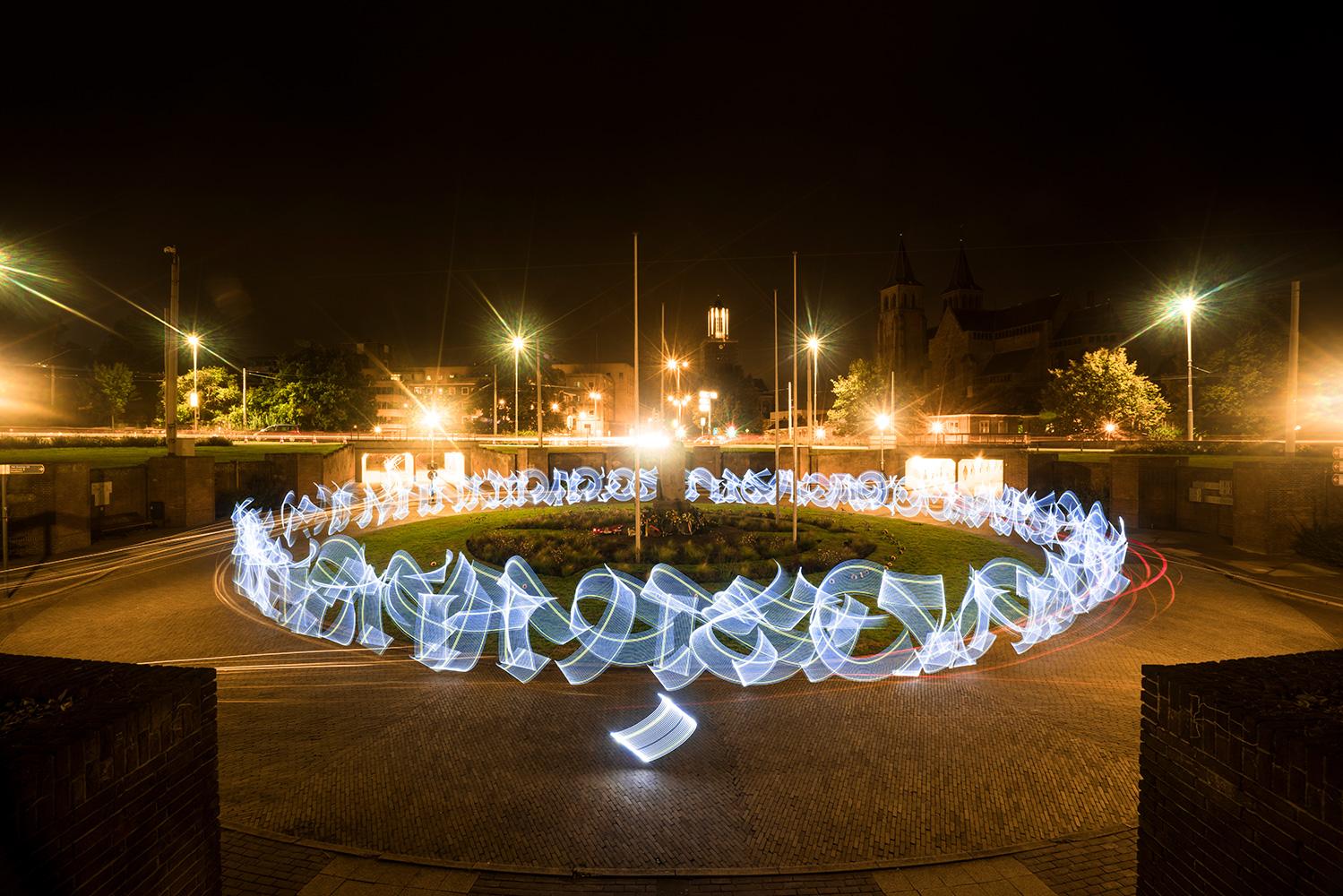
Said Dokins & Leonardo Luna, ‘the issue is never abstract war, but always concrete war, specifically imperialist war, and that is a phenomenon of economic life WB), Heliographies of Memory series, 2017. Arnhem, Netherlands.
Amsterdam
It is surprising how many bicycles can be seen in Amsterdam! kilometers and kilometers of cycling routes, canals with small boats that can take you from one place to another. We were invited by Street Art Today to collaborate in the project of the Urban Art Museum, that will be open next year.
We worked in Amsterdam-Noord, the old industrial area across the IJ river. Currently, it’s going through an accelerated process of gentrification, that has given rise to a new urban area at the river shore with hotels, restaurants, galleries and museums that have turned the neighborhood into a place of production and consumerism characteristic of post-industrial cities. From another perspective, the local people of that side of the river that had lived there through generations in social care housing, feel every day more unconnected to their own neighborhood.

Said Dokins & Leonardo Luna, ‘Desplazamientos’ (‘Displacements’), Heliographies of Memory series, 2017. Amsterdam-Noord, Netherlands.

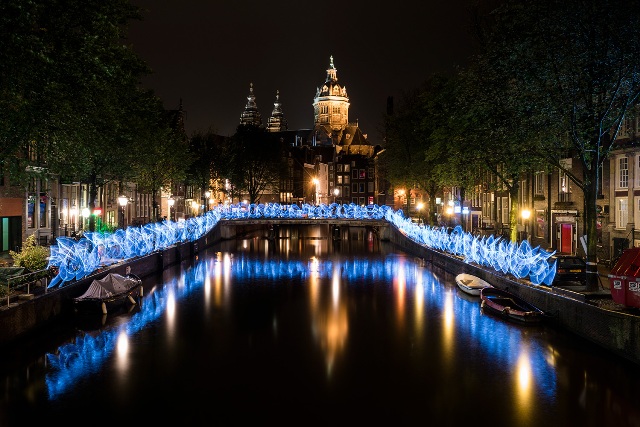
You may consider a modest donation — however much you can afford, when it comes from the heart, it’s the kind of gesture that makes us warm with appreciation.
leave your comment